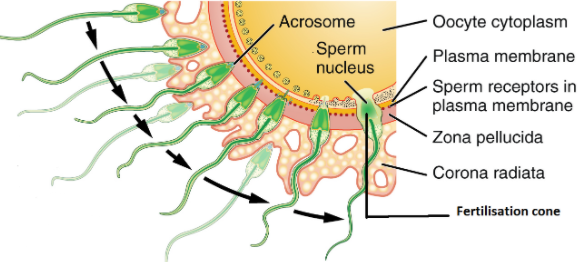
Answer
441.9k+ views
Hint:The union of male sperm and female egg to form a zygote is known as fertilisation. A cone like projection protruding from the surface of eggs at the point of contact with the sperm is called fertilisation cone.
Complete Answer:
The human sperm is a highly mobile structure which consist of
Acrosomal head- It is the covering around the head which contains enzymes called acrosome which helps in penetration of sperm into the egg.
Body- It contains nucleus, mitochondria and other organelles.
Flagella- It helps in movement. The tail is activated by the process called capacitation when it enters the female body.
Once the sperm reaches the egg, the enzyme in the acrosome is activated. This is called an acrosome reaction. During this process the fertilisation cone is developed on the surface of the plasma membrane of the egg which pulls the sperm towards itself. It enables the sperm to penetrate the thick coat surrounding the egg.
The membrane of sperm fuses with egg and sperm nucleus fuses with the egg.

Vitelline layer of egg- It is a transparent layer which encloses the yolk of hen’s egg.
The correct answer is the fertilisation cone, which pulls the sperm into the egg, is formed from the plasma membrane.
Hence the correct answer is option ‘D’.
Note:The acrosome reaction allows the sperm to penetrate the zona pellucida of the egg. It stimulates the fusion between the plasma membrane and the acrosomal membrane by forming a cone like structure which helps in easy penetration of sperm in the egg.
Complete Answer:
The human sperm is a highly mobile structure which consist of
Acrosomal head- It is the covering around the head which contains enzymes called acrosome which helps in penetration of sperm into the egg.
Body- It contains nucleus, mitochondria and other organelles.
Flagella- It helps in movement. The tail is activated by the process called capacitation when it enters the female body.
Once the sperm reaches the egg, the enzyme in the acrosome is activated. This is called an acrosome reaction. During this process the fertilisation cone is developed on the surface of the plasma membrane of the egg which pulls the sperm towards itself. It enables the sperm to penetrate the thick coat surrounding the egg.
The membrane of sperm fuses with egg and sperm nucleus fuses with the egg.

Vitelline layer of egg- It is a transparent layer which encloses the yolk of hen’s egg.
The correct answer is the fertilisation cone, which pulls the sperm into the egg, is formed from the plasma membrane.
Hence the correct answer is option ‘D’.
Note:The acrosome reaction allows the sperm to penetrate the zona pellucida of the egg. It stimulates the fusion between the plasma membrane and the acrosomal membrane by forming a cone like structure which helps in easy penetration of sperm in the egg.
Recently Updated Pages
How many sigma and pi bonds are present in HCequiv class 11 chemistry CBSE

Mark and label the given geoinformation on the outline class 11 social science CBSE

When people say No pun intended what does that mea class 8 english CBSE

Name the states which share their boundary with Indias class 9 social science CBSE

Give an account of the Northern Plains of India class 9 social science CBSE

Change the following sentences into negative and interrogative class 10 english CBSE

Trending doubts
Fill the blanks with the suitable prepositions 1 The class 9 english CBSE

The Equation xxx + 2 is Satisfied when x is Equal to Class 10 Maths

In Indian rupees 1 trillion is equal to how many c class 8 maths CBSE

Which are the Top 10 Largest Countries of the World?

How do you graph the function fx 4x class 9 maths CBSE

Give 10 examples for herbs , shrubs , climbers , creepers

Difference Between Plant Cell and Animal Cell

Difference between Prokaryotic cell and Eukaryotic class 11 biology CBSE

Why is there a time difference of about 5 hours between class 10 social science CBSE



